Temperature Sensor ICs Simplif
Abstract: When you set out to select a temperature sensor, you are no longer limited to either an analog output or a digital output device. There is now a broad selecTIon of sensor types, one of which should match your system's needs. This applicaTIon note surveys the wide variety of temperature sensor ICs available to help the designer make the best choice for a parTIcular design.
When you set out to select a temperature sensor, you are no longer limited to either an analog-output or a digital-output device. There is now a broad selecTIon of sensor types, one of which should match your system's needs.
When asked what I do for a living, I tell people I'm an analog electronics engineer. When next asked, "What does 'analog' mean?" I often use temperature sensors to explain the concept. I tell them that we engineers sometimes use sensors that give an analog of temperature in the form of voltage or current. To further define the analog world, I contrast it with the digital realm by saying that the voltage or current signals are usually converted to 1s and 0s so that computers can use the information. Sometimes this explanation suffices; sometimes it doesn't.
What this explanation does do is suggest the basic migration of temperature sensors. Until recently, all the temperature sensors on the market provided analog outputs. Thermistors, RTDs, and thermocouples were followed by another analog-output device, the silicon temperature sensor. In most applications, unfortunately, these analog-output devices require a comparator, an ADC, or an amplifier at their output to make them useful.
Thus, when higher levels of integration became feasible, temperature sensors with digital interfaces became available. These ICs are sold in a variety of forms, from simple devices that signal when a specific temperature has been exceeded to those that report both remote and local temperatures while providing warnings at programmed temperature settings. The choice now isn't simply between analog-output and digital-output sensors; there is a broad range of sensor types from which to choose.
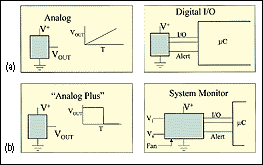
Figure 1. Sensor and IC manufacturers currently offer four classes of temperature sensors.
"Analog-plus" sensors (C) are available with various types of digital outputs. The VOUT versus temperature curve is for an IC whose digital output switches when a specific temperature has been exceeded. In this case, the "plus" added to the analog temperature sensor is nothing more than a comparator and a voltage reference. Other types of "plus" parts ship temperature data in the form of the delay time after the part has been strobed, or in the form of the frequency or the period of a square wave, which will be discussed later.
The system monitor (D) is the most complex IC of the four. In addition to the functions provided by the digital I/O type, this type of device commonly monitors the system supply voltages, providing an alarm when voltages rise above or sink below limits set via the I/O bus. Fan monitoring and/or control is sometimes included in this type of IC. In some cases, this class of device is used to determine whether or not a fan is working. More complex versions control the fan as a function of one or more measured temperatures. The system monitor sensor is not discussed here but is briefly mentioned to give a complete picture of the types of temperature sensors available.
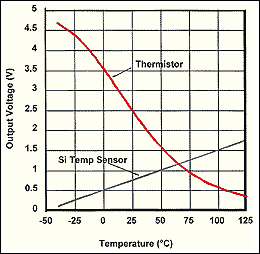
Figure 2. The linearity of thermistors and silicon temperature sensors, two popular analog-output temperature detectors, is contrasted sharply.
Silicon temperature sensors come with different output scales and offsets. Some, for example, are available with output transfer functions that are proportional to K, others to °C or °F. Some of the °C parts provide an offset so that negative temperatures can be monitored using a single-ended supply.
In most applications, the output of these devices is fed into a comparator or an A/D converter to convert the temperature data into a digital format. Despite the need for these additional devices, thermistors and silicon temperature sensors continue to enjoy popularity due to low cost and convenience of use in many situations.
This type of device is available with a wide variety of features, among them, remote temperature sensing. To enable remote sensing, most high-performance CPUs include an on-chip transistor that provides a voltage analog of the temperature. (Only one of the transistor's two p-n junctions is used.) Figure 3 shows a remote CPU being monitored using this technique. Other applications utilize a discrete transistor to perform the same function.
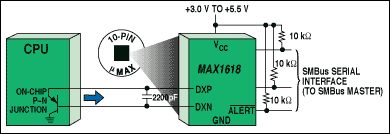
Figure 3. A user-programmable temperature sensor monitors the temperature of a remote CPU's on-chip p-n junction.
Another important feature found on some of these types of sensors (including the sensor shown in Figure 3) is the ability to interrupt a microcontroller when the measured temperature falls outside a range bounded by high and low limits. On other sensors, an interrupt is generated when the measured temperature exceeds either a high or a low temperature threshold (i.e., not both). For the sensor in Figure 3, those limits are transmitted to the temperature sensor via the SMBus interface. If the temperature moves above or below the circumscribed range, the alert signal interrupts the processor.
Pictured in Figure 4 is a similar device. Instead of monitoring one p-n junction, however, it monitors four junctions and its own internal temperature. Because Maxim's MAX1668 consumes a small amount of power, its internal temperature is close to the ambient temperature. Measuring the ambient temperature gives an indication as to whether or not the system fan is operating properly.
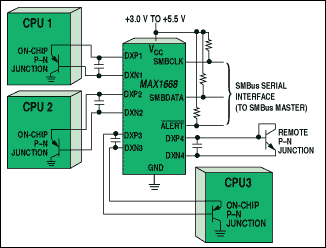
Figure 4. A user-programmable temperature sensor monitors its own local temperature and the temperatures of four remote p-n junctions.
Controlling a fan while monitoring remote temperature is the chief function of the IC shown in Figure 5. Users of this part can choose between two different modes of fan control. In the PWM mode, the microcontroller controls the fan speed as a function of the measured temperature by changing the duty cycle of the signal sent to the fan. This permits the power consumption to be far less than that of the linear mode of control that this part also provides. Because some fans emit an audible sound at the frequency of the PWM signal controlling it, the linear mode can be advantageous, but at the price of higher power consumption and additional circuitry. The added power consumption is a small fraction of the power consumed by the entire system, though.
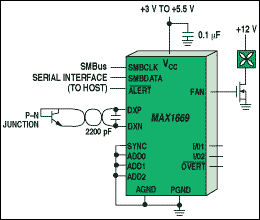
Figure 5. A fan controller/temperature sensor IC uses either a PWM- or linear-mode control scheme.
This IC provides the alert signal that interrupts the microcontroller when the temperature violates specified limits. A safety feature in the form of the signal called "overt" (an abbreviated version of "over temperature") is also provided. If the microcontroller or the software were to lock up while temperature is rising to a dangerous level, the alert signal would no longer be useful. However, overt, which goes active once the temperature rises above a level set via the SMBus, is typically used to control circuitry without the aid of the microcontroller. Thus, in this high-temperature scenario with the microcontroller not functioning, overt could be used to shut down the system power supplies directly, without the microcontroller, and prevent a potentially catastrophic failure.
This digital I/O class of devices finds widespread use in servers, battery packs, and hard-disk drives. Temperature is monitored in numerous locations to increase a server's reliability: at the motherboard (which is essentially the ambient temperature inside the chassis), inside the CPU die, and at other heat-generating components such as graphics accelerators and hard-disk drives. Battery packs incorporate temperature sensors for safety reasons and to optimize charging profiles, which maximizes battery life.
There are two good reasons for monitoring the temperature of a hard-disk drive, which depends primarily on the speed of the spindle motor and the ambient temperature: The read errors in a drive increase at temperature extremes, and a hard disk's MTBF is improved significantly through temperature control. By measuring the temperature within the system, you can control motor speed to optimize reliability and performance. The drive can also be shut down. In high-end systems, alerts can be generated for the system administrator to indicate temperature extremes or situations where data loss is possible.
In the simplest instance of an analog-plus sensor, the logic output trips when a specific temperature is exceeded. Some of these devices are tripped when temperature rises above a preset threshold, others, when temperature drops below a threshold. Some of these sensors allow the temperature threshold to be adjusted with a resistor, whereas others have fixed thresholds.
The devices shown in Figure 6 are purchased with a specific internal temperature threshold. The three circuits illustrate common uses for this type of device: providing a warning, shutting down a piece of equipment, or turning on a fan.
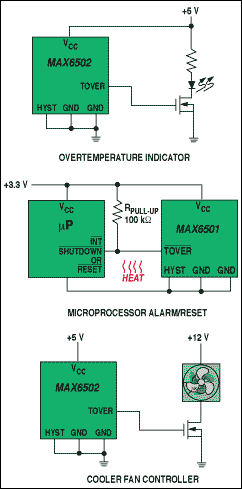
Figure 6. ICs that signal when a temperature has been exceeded are well suited for over/undertemperature alarms and simple on/off fan control.
When an actual temperature reading is needed, and a microcontroller is available, sensors that transmit the reading on a single line can be useful. With the microcontroller's internal counter measuring time, the signals from this type of temperature sensor are readily transformed to a measure of temperature. The sensor in Figure 7 outputs a square wave whose frequency is proportional to the ambient temperature in Kelvin. The device in Figure 8 is similar, but the period of the square wave is proportional to the ambient temperature in kelvins.
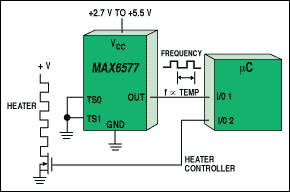
Figure 7. A temperature sensor that transmits a square wave whose frequency is proportional to the measured temperature in Kelvin forms part of a heater controller circuit.
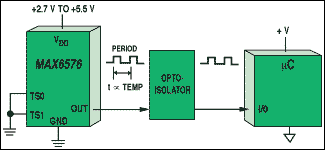
Figure 8. This temperature sensor transmits a square wave whose period is proportional to the measured temperature in Kelvin. Because only a single line is needed to send temperature information, just a single optoisolator is required to isolate the signal path.
Figure 9, a truly novel approach, allows up to eight temperature sensors to be connected on this common line. The process of extracting temperature data from these sensors begins when the microcontroller's I/O port strobes all the sensors on the line simultaneously. The microcontroller is then quickly reconfigured as an input in order to receive data from each of the sensors. The data are encoded as the amount of time that transpires after the sensors are strobed. Each of the sensors encodes this time after the strobe pulse within a specific range of time. Collisions are avoided by assigning each sensor its own permissible time range.
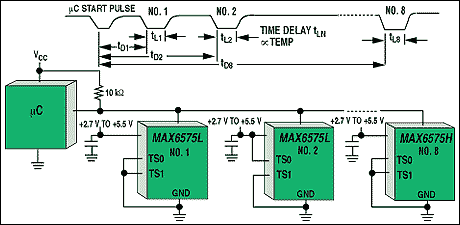
Figure 9. A microcontroller strobes up to eight temperature sensors connected on a common line and receives the temperature data transmitted from each sensor on the same line.
The accuracy achieved by this method is surprisingly high: 0.8°C is typical at room temperature, precisely matching that of the IC that encodes temperature data in the form of the frequency of the transmitted square wave. The same is true of the device that uses the period of the square wave.
These devices are outstanding in wire-limited applications. For example, when a temperature sensor must be isolated from the microcontroller, costs are kept to a minimum because only one optoisolator is needed. These sensors are also of great utility in automotive and HVAC applications, because they reduce the amount of copper running over distances.
A similar version of this article appeared in the January 2000 issue of Sensors.
When you set out to select a temperature sensor, you are no longer limited to either an analog-output or a digital-output device. There is now a broad selecTIon of sensor types, one of which should match your system's needs.
When asked what I do for a living, I tell people I'm an analog electronics engineer. When next asked, "What does 'analog' mean?" I often use temperature sensors to explain the concept. I tell them that we engineers sometimes use sensors that give an analog of temperature in the form of voltage or current. To further define the analog world, I contrast it with the digital realm by saying that the voltage or current signals are usually converted to 1s and 0s so that computers can use the information. Sometimes this explanation suffices; sometimes it doesn't.
What this explanation does do is suggest the basic migration of temperature sensors. Until recently, all the temperature sensors on the market provided analog outputs. Thermistors, RTDs, and thermocouples were followed by another analog-output device, the silicon temperature sensor. In most applications, unfortunately, these analog-output devices require a comparator, an ADC, or an amplifier at their output to make them useful.
Thus, when higher levels of integration became feasible, temperature sensors with digital interfaces became available. These ICs are sold in a variety of forms, from simple devices that signal when a specific temperature has been exceeded to those that report both remote and local temperatures while providing warnings at programmed temperature settings. The choice now isn't simply between analog-output and digital-output sensors; there is a broad range of sensor types from which to choose.
Classes of Temperature Sensors

Figure 1. Sensor and IC manufacturers currently offer four classes of temperature sensors.
"Analog-plus" sensors (C) are available with various types of digital outputs. The VOUT versus temperature curve is for an IC whose digital output switches when a specific temperature has been exceeded. In this case, the "plus" added to the analog temperature sensor is nothing more than a comparator and a voltage reference. Other types of "plus" parts ship temperature data in the form of the delay time after the part has been strobed, or in the form of the frequency or the period of a square wave, which will be discussed later.
The system monitor (D) is the most complex IC of the four. In addition to the functions provided by the digital I/O type, this type of device commonly monitors the system supply voltages, providing an alarm when voltages rise above or sink below limits set via the I/O bus. Fan monitoring and/or control is sometimes included in this type of IC. In some cases, this class of device is used to determine whether or not a fan is working. More complex versions control the fan as a function of one or more measured temperatures. The system monitor sensor is not discussed here but is briefly mentioned to give a complete picture of the types of temperature sensors available.
Analog-Output Temperature Sensors
Thermistors and silicon temperature sensors are widely used forms of analog-output temperature sensors. Figure 2 clearly shows that when a linear relationship between voltage and temperature is needed, a silicon temperature sensor is a far better choice than a thermistor. Over a narrow temperature range, however, thermistors can provide reasonable linearity and good sensitivity. Many circuits originally constructed with thermistors have over time been updated using silicon temperature sensors.
Figure 2. The linearity of thermistors and silicon temperature sensors, two popular analog-output temperature detectors, is contrasted sharply.
Silicon temperature sensors come with different output scales and offsets. Some, for example, are available with output transfer functions that are proportional to K, others to °C or °F. Some of the °C parts provide an offset so that negative temperatures can be monitored using a single-ended supply.
In most applications, the output of these devices is fed into a comparator or an A/D converter to convert the temperature data into a digital format. Despite the need for these additional devices, thermistors and silicon temperature sensors continue to enjoy popularity due to low cost and convenience of use in many situations.
Digital I/O Temperature Sensors
About five years ago, a new type of temperature sensor was introduced. These devices include a digital interface that permits communication with a microcontroller. The interface is usually an I²C or SMBus serial bus, but other serial interfaces such as SPI are common. In addition to reporting temperature readings to the microcontroller, the interface also receives instructions from the microcontroller. Those instructions are often temperature limits, which, if exceeded, activate a digital signal on the temperature sensor IC that interrupts the microcontroller. The microcontroller is then able to adjust fan speed or back off the speed of a microprocessor, for example, to keep temperature under control.This type of device is available with a wide variety of features, among them, remote temperature sensing. To enable remote sensing, most high-performance CPUs include an on-chip transistor that provides a voltage analog of the temperature. (Only one of the transistor's two p-n junctions is used.) Figure 3 shows a remote CPU being monitored using this technique. Other applications utilize a discrete transistor to perform the same function.

Figure 3. A user-programmable temperature sensor monitors the temperature of a remote CPU's on-chip p-n junction.
Another important feature found on some of these types of sensors (including the sensor shown in Figure 3) is the ability to interrupt a microcontroller when the measured temperature falls outside a range bounded by high and low limits. On other sensors, an interrupt is generated when the measured temperature exceeds either a high or a low temperature threshold (i.e., not both). For the sensor in Figure 3, those limits are transmitted to the temperature sensor via the SMBus interface. If the temperature moves above or below the circumscribed range, the alert signal interrupts the processor.
Pictured in Figure 4 is a similar device. Instead of monitoring one p-n junction, however, it monitors four junctions and its own internal temperature. Because Maxim's MAX1668 consumes a small amount of power, its internal temperature is close to the ambient temperature. Measuring the ambient temperature gives an indication as to whether or not the system fan is operating properly.

Figure 4. A user-programmable temperature sensor monitors its own local temperature and the temperatures of four remote p-n junctions.
Controlling a fan while monitoring remote temperature is the chief function of the IC shown in Figure 5. Users of this part can choose between two different modes of fan control. In the PWM mode, the microcontroller controls the fan speed as a function of the measured temperature by changing the duty cycle of the signal sent to the fan. This permits the power consumption to be far less than that of the linear mode of control that this part also provides. Because some fans emit an audible sound at the frequency of the PWM signal controlling it, the linear mode can be advantageous, but at the price of higher power consumption and additional circuitry. The added power consumption is a small fraction of the power consumed by the entire system, though.

Figure 5. A fan controller/temperature sensor IC uses either a PWM- or linear-mode control scheme.
This IC provides the alert signal that interrupts the microcontroller when the temperature violates specified limits. A safety feature in the form of the signal called "overt" (an abbreviated version of "over temperature") is also provided. If the microcontroller or the software were to lock up while temperature is rising to a dangerous level, the alert signal would no longer be useful. However, overt, which goes active once the temperature rises above a level set via the SMBus, is typically used to control circuitry without the aid of the microcontroller. Thus, in this high-temperature scenario with the microcontroller not functioning, overt could be used to shut down the system power supplies directly, without the microcontroller, and prevent a potentially catastrophic failure.
This digital I/O class of devices finds widespread use in servers, battery packs, and hard-disk drives. Temperature is monitored in numerous locations to increase a server's reliability: at the motherboard (which is essentially the ambient temperature inside the chassis), inside the CPU die, and at other heat-generating components such as graphics accelerators and hard-disk drives. Battery packs incorporate temperature sensors for safety reasons and to optimize charging profiles, which maximizes battery life.
There are two good reasons for monitoring the temperature of a hard-disk drive, which depends primarily on the speed of the spindle motor and the ambient temperature: The read errors in a drive increase at temperature extremes, and a hard disk's MTBF is improved significantly through temperature control. By measuring the temperature within the system, you can control motor speed to optimize reliability and performance. The drive can also be shut down. In high-end systems, alerts can be generated for the system administrator to indicate temperature extremes or situations where data loss is possible.
Analog-Plus Temperature Sensors
"Analog-plus" sensors are generally suited to simpler measurement applications. These ICs generate a logic output derived from the measured temperature and are distinguished from digital I/O sensors primarily because they output data on a single line, as opposed to a serial bus.In the simplest instance of an analog-plus sensor, the logic output trips when a specific temperature is exceeded. Some of these devices are tripped when temperature rises above a preset threshold, others, when temperature drops below a threshold. Some of these sensors allow the temperature threshold to be adjusted with a resistor, whereas others have fixed thresholds.
The devices shown in Figure 6 are purchased with a specific internal temperature threshold. The three circuits illustrate common uses for this type of device: providing a warning, shutting down a piece of equipment, or turning on a fan.

Figure 6. ICs that signal when a temperature has been exceeded are well suited for over/undertemperature alarms and simple on/off fan control.
When an actual temperature reading is needed, and a microcontroller is available, sensors that transmit the reading on a single line can be useful. With the microcontroller's internal counter measuring time, the signals from this type of temperature sensor are readily transformed to a measure of temperature. The sensor in Figure 7 outputs a square wave whose frequency is proportional to the ambient temperature in Kelvin. The device in Figure 8 is similar, but the period of the square wave is proportional to the ambient temperature in kelvins.

Figure 7. A temperature sensor that transmits a square wave whose frequency is proportional to the measured temperature in Kelvin forms part of a heater controller circuit.

Figure 8. This temperature sensor transmits a square wave whose period is proportional to the measured temperature in Kelvin. Because only a single line is needed to send temperature information, just a single optoisolator is required to isolate the signal path.
Figure 9, a truly novel approach, allows up to eight temperature sensors to be connected on this common line. The process of extracting temperature data from these sensors begins when the microcontroller's I/O port strobes all the sensors on the line simultaneously. The microcontroller is then quickly reconfigured as an input in order to receive data from each of the sensors. The data are encoded as the amount of time that transpires after the sensors are strobed. Each of the sensors encodes this time after the strobe pulse within a specific range of time. Collisions are avoided by assigning each sensor its own permissible time range.

Figure 9. A microcontroller strobes up to eight temperature sensors connected on a common line and receives the temperature data transmitted from each sensor on the same line.
The accuracy achieved by this method is surprisingly high: 0.8°C is typical at room temperature, precisely matching that of the IC that encodes temperature data in the form of the frequency of the transmitted square wave. The same is true of the device that uses the period of the square wave.
These devices are outstanding in wire-limited applications. For example, when a temperature sensor must be isolated from the microcontroller, costs are kept to a minimum because only one optoisolator is needed. These sensors are also of great utility in automotive and HVAC applications, because they reduce the amount of copper running over distances.
Anticipated Temperature Sensor Developments
IC temperature sensors provide a varied array of functions and interfaces. As these devices continue to evolve, system designers will see more application-specific features as well as new ways of interfacing the sensors to the system. Finally, the ability of chip designers to integrate more electronics in the same die area ensures that temperature sensors will soon include new functions and special interfaces.A similar version of this article appeared in the January 2000 issue of Sensors.



评论